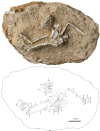Early evolution of diurnal habits in owls (Aves, Strigiformes) documented by a new and exquisitely preserved Miocene owl fossil from China
- PMID: 35344399
- PMCID: PMC9169863
- DOI: 10.1073/pnas.2119217119
Early evolution of diurnal habits in owls (Aves, Strigiformes) documented by a new and exquisitely preserved Miocene owl fossil from China
Abstract
SignificanceOwls, with their largely nocturnal habits, contrast strikingly with the vast majority of diurnal birds. A new spectacular late Miocene owl skeleton from China unexpectedly preserves the oldest evidence for daytime behavior in owls. The extinct owl is a member of the clade Surniini, which contains most living diurnal owl species. Analysis of the preserved eye bones documents them as consistent with diurnal birds, and phylogenetically constrained character mapping coincides with a reconstruction of an early evolutionary reversal away from nocturnal habits in this owl group. These results support a potential Miocene origin of nonnocturnal habits in a globally distributed owl group, which may be linked to steppe habitat expansion and climatic cooling in the late Miocene.
Keywords: Linxia; Strigidae; Surniini; diurnal; fossil.
Conflict of interest statement
The authors declare no competing interest.
Figures





Similar articles
-
Cranial evolution in the extinct Rodrigues Island owl Otus murivorus (Strigidae), associated with unexpected ecological adaptations.Sci Rep. 2020 Aug 20;10(1):14019. doi: 10.1038/s41598-020-69868-1. Sci Rep. 2020. PMID: 32820225 Free PMC article.
-
Eye shape and retinal topography in owls (Aves: Strigiformes).Brain Behav Evol. 2012;79(4):218-36. doi: 10.1159/000337760. Epub 2012 Jun 18. Brain Behav Evol. 2012. PMID: 22722085
-
A new species of extinct scops owl (Aves: Strigiformes: Strigidae: Otus) from São Miguel Island (Azores Archipelago, North Atlantic Ocean).Zootaxa. 2013;3647:343-57. doi: 10.11646/zootaxa.3647.2.6. Zootaxa. 2013. PMID: 26295111
-
Evolving between land and water: key questions on the emergence and history of the Hippopotamidae (Hippopotamoidea, Cetancodonta, Cetartiodactyla).Biol Rev Camb Philos Soc. 2011 Aug;86(3):601-25. doi: 10.1111/j.1469-185X.2010.00162.x. Epub 2010 Oct 15. Biol Rev Camb Philos Soc. 2011. PMID: 20946539 Review.
-
Last Common Ancestor of Apes and Humans: Morphology and Environment.Folia Primatol (Basel). 2020;91(2):122-148. doi: 10.1159/000501557. Epub 2019 Sep 18. Folia Primatol (Basel). 2020. PMID: 31533109 Review.
Cited by
-
Mitochondrial genome analysis, phylogeny and divergence time evaluation of Strixaluco (Aves, Strigiformes, Strigidae).Biodivers Data J. 2023 Mar 20;11:e101942. doi: 10.3897/BDJ.11.e101942. eCollection 2023. Biodivers Data J. 2023. PMID: 38327340 Free PMC article.
-
The Rising of Paleontology in China: A Century-Long Road.Biology (Basel). 2022 Jul 25;11(8):1104. doi: 10.3390/biology11081104. Biology (Basel). 2022. PMID: 35892960 Free PMC article. Review.
References
-
- Gaynor K. M., Hojnowski C. E., Carter N. H., Brashares J. S., The influence of human disturbance on wildlife nocturnality. Science 360, 1232–1235 (2018). - PubMed
-
- Mukhin A., Grinkevich V., Helm B., Under cover of darkness: Nocturnal life of diurnal birds. J. Biol. Rhythms 24, 225–231 (2009). - PubMed
-
- Schmitz L., Motani R., Nocturnality in dinosaurs inferred from scleral ring and orbit morphology. Science 332, 705–708 (2011). - PubMed
-
- Davies W. I., Collin S. P., Hunt D. M., Molecular ecology and adaptation of visual photopigments in craniates. Mol. Ecol. 21, 3121–3158 (2012). - PubMed
MeSH terms
LinkOut - more resources
Full Text Sources

